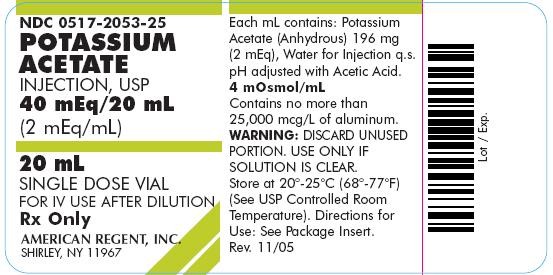Potassium Acetate
POTASSIUM ACETATE INJECTION, USP, 2 mEq/mL, 4 mOsmol/mL
FULL PRESCRIBING INFORMATION
Rx Only
| 100 mL PHARMACY BULK PACKAGE NOT FOR DIRECT INFUSION |
Potassium Acetate Injection, USP, 2 mEq/mL, is a sterile, nonpyrogenic solution of Potassium Acetate (C2H3KO2) in Water for Injection. It must be diluted prior to administration.
Each mL contains Potassium Acetate (Anhydrous) 196 mg (equivalent to 2 mEq/mL), Water for Injection q.s. pH may be adjusted with Acetic Acid. Contains no bacteriostatic agent or other preservatives.
Potassium is found in low concentration in plasma and extracellular fluids. It is the chief cation of body cells, and is concerned with the maintenance of the body fluid composition and electrolyte balance. The major amount of potassium is excreted in the urine. Therefore, the kidney normally determines potassium balance.
The acetate ion is completely metabolized in the body, providing a source of hydrogen ion acceptors.
Potassium Acetate Injection, USP, is indicated in the treatment of potassium deficiency states when oral replacement therapy is not feasible.
The solution is intended as an alternative to Potassium Chloride to provide Potassium (K+) for addition to large volume infusion fluids for intravenous use.
Potassium Acetate Injection, USP, administration is contraindicated in diseases where high potassium levels may be encountered.
Potassium Acetate Injection, USP, must be diluted before use. To avoid potassium intoxication, infuse potassium containing solutions slowly. Potassium replacement therapy should be monitored whenever possible by continuous or serial electrocardiography.
Solutions containing potassium ions should be used with great care, if at all, in patients with hyperkalemia, severe renal failure and in conditions in which potassium retention is present.
In patients with diminished renal function, administration of solutions containing potassium ions may result in potassium retention.
Solutions containing acetate ion should be used with great care in patients with metabolic or respiratory alkalosis. Acetate should be administered with great care in those conditions in which there is an increased level or an impaired utilization of this ion, such as severe hepatic insufficiency.
This product contains aluminum that may be toxic. Aluminum may reach toxic levels with prolonged parenteral administration if kidney function is impaired. Premature neonates are particularly at risk because their kidneys are immature, and they require large amounts of calcium and phosphate solutions, which contain aluminum.
Research indicates that patients with impaired kidney function, including premature neonates, who receive parenteral levels of aluminum at greater than 4 to 5 mcg/kg/day accumulate aluminum at levels associated with central nervous system and bone toxicity. Tissue loading may occur at even lower rates of administration.
Potassium replacement therapy should be guided primarily by serial electrocardiograms. Plasma potassium levels are not necessarily indicative of tissue potassium levels.
High plasma concentrations of potassium may cause death through cardiac depression, arrhythmias or arrest. Potassium Acetate Injection, USP, should be used with caution in the presence of cardiac disease, particularly in digitalized patients or in the presence of renal disease, metabolic acidosis, Addison’s disease, acute dehydration, prolonged or severe diarrhea, familial periodic paralysis, hypoadrenalism, hyperkalemia, hyponatremia and myotonia congenita.
Pregnancy Category C: Safety for use in pregnancy has not been established. Use of potassium acetate in women of childbearing potential requires that anticipated benefits be weighed against possible hazards.
Nausea, vomiting, abdominal pain and diarrhea have been reported. The signs and symptoms of potassium intoxication include paresthesias of the extremities, flaccid paralysis, listlessness, mental confusion, weakness and heaviness of the legs, hypotension, cardiac arrhythmias, heart block, electrocardiographic abnormalities such as disappearance of P waves, spreading and slurring of the QRS complex with development of a biphasic curve, and cardiac arrest. (SeeWARNINGSandPRECAUTIONS.)
In the event of overdosage, discontinue the infusion immediately, and institute intensive corrective therapy to reduce the serum potassium levels and restore acid-base balance if necessary. (SeeWARNINGS , PRECAUTIONSandADVERSE REACTIONS.)
Potassium Acetate Injection, USP (2 mEq/mL) must be diluted before administration.
The dose and rate of administration are dependent upon the individual condition of each patient. ECG and serum potassium should be monitored as a guide to dosage. Withdraw the calculated volume aseptically and transfer to appropriate intravenous fluids to provide the desired number of milliequivalents of potassium (K+) with an equal number of milliequivalents of acetate (CH3COO−).
Parenteral drug products should be inspected visually for particulate matter and discoloration, whenever solution and container permit. Discard vial within 4 hours of initial entry.
DIRECTIONS FOR DISPENSING FROM 100 mL PHARMACY BULK PACKAGE - NOT FOR DIRECT INFUSION
The 100 mL Pharmacy Bulk Package is for use in a Pharmacy Admixture Service only. The 100 mL Pharmacy Bulk Package should be suspended (inverted) by its IV hang label in a laminar flow hood or biological safety cabinet. Prior to entering a Pharmacy Bulk Package remove the flip-off seal and cleanse the rubber closure with a suitable antiseptic agent. Entry into the Pharmacy Bulk Package must be made with a sterile transfer set or other sterile dispensing device and the contents dispensed in aliquots using aseptic technique. Use of a syringe needle is not recommended as it may cause leakage. ANY UNUSED PORTION MUST BE DISCARDED WITHIN 4 HOURS AFTER INITIAL ENTRY. The date and the time the Pharmacy Bulk Package was initially opened should be recorded in the space provided on the Pharmacy Bulk Package label.
Potassium Acetate Injection, USP 2 mEq/mL
| NDC 0517-2053-25 | 20 mL Single Dose Vial | Packaged in boxes of 25 |
| NDC 0517-2450-25 | 50 mL Single Dose Vial | Packaged in boxes of 25 |
| NDC 0517-2400-25 | 100 mL Pharmacy Bulk Package | Packaged in boxes of 25 |
Store at 20o-25oC (68o-77oF);excursions permitted to 15o-30oC (59o-86oF) (See USP Controlled Room Temperature).
AMERICAN
REGENT, INC
SHIRLEY, NY 11967
IN2053
Rev. 11/05
PRINCIPLE DISPLAY PANEL – 20 mL Container
NDC 0517-2053-25
POTASSIUM ACETATE INJECTION, USP
40 mEq/20 mL
(2 mEq/mL)
20 mL SINGLE DOSE VIAL
FOR IV USE AFTER DILUTION
Rx Only
AMERICAN REGENT, INC.
SHIRLEY, NY 11967

Potassium AcetatePotassium Acetate INJECTION, SOLUTION
| |||||||||||||||||||||||||||||||||||||||||||||||||||||||||||||||